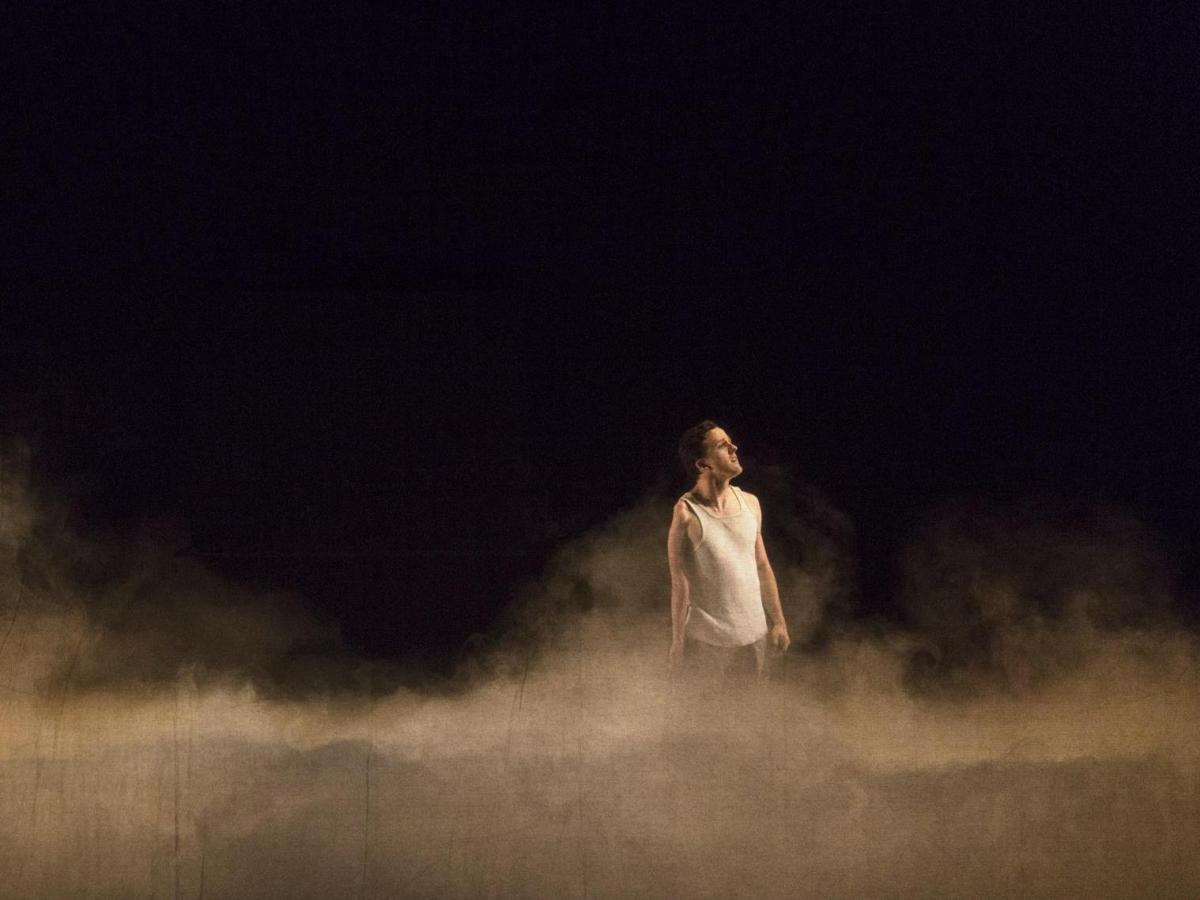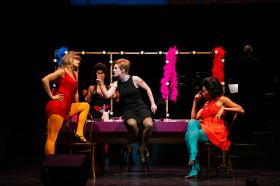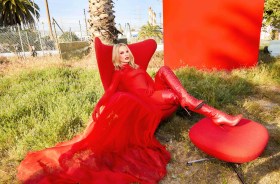Daniel Monks as Joseph Merrick in Malthouse Theatre’s The Real and Imagined History of the Elephant Man. Photo by Pia Johnson.
Fog swirls, evoking the dark streets of Victorian England and the hissing jets of the steam age. A young boy calls for his drunken father, who curses ‘This blighted world and its blighted progeny,’ before decrying the relentless advance of industry and its dark Satanic mills; mills which ‘Churn, churn, churn,’ creating an endless parade of identical goods: ‘Bolts of cloth all the same. Spoons and forks, all the same … Big machines make everything the same, and we are becoming all the same,’ the man wails.
He leans on his son, who helps him home. Soon he will warn the boy, ‘This is the age of sameness. This world hates anything different.’
The father – unnamed in this production – is Merrick, a carriage driver and resident of the English city of Leicester. Despite his warnings his son will grow up to be distinctly different; to be unlike other men.
His son’s name is Joseph Merrick – more commonly known by the uncomfortable soubriquet, the Elephant Man.
Much of what we know of Joseph Merrick’s life comes from the book The Elephant Man and Other Reminiscences, by London surgeon Sir Frederick Treves.
Despite mistakenly and persistently calling Joseph, ‘John’, throughout the book, Treves nonetheless represented himself as his patient’s close friend.
Merrick and Treves were undeniably in regular contact during Merrick’s later years; nonetheless Joseph shared few personal details about his childhood with the good doctor.
Perhaps it is for this reason that Matthew Lutton’s production of Tom Wright’s new play, The Real and Imagined History of the Elephant Man, presents its early scenes behind a scrim, though which we peer at events whose factual basis can never be truly known. Or does this translucent curtain represent the lens through which the majority of us – our vision coloured by ablest perspectives – view Merrick’s life and story?
Joseph Merrick was a singular man. Whether in sideshows, where common folk clustered to gawk at him; or under Treves’ care in the Royal London Hospital, where his visitors were of higher social status but no less eager for spectacle, he was singled out for attention.
We do not know how this attention made him feel – we have no firsthand accounts of Merrick’s own views and experiences – and he died in 1890, aged 27. After his death, his ‘friend’ Dr Treves dissected Merrick’s body, took plaster casts of his head and limbs, and mounted his skeleton for display, the way a hunter might mount a stag’s head or a particularly large trout.
Tom Wright’s retelling of this tale (previously adapted for the stage by US playwright Bernard Pomerance in 1977, with David Lynch’s 1980 film The Elephant Man covering similar ground; both featuring able-bodied actors in the title roles) employs a poetic tone to tell Merrick’s story.
The fact that our knowledge of Merrick is fragmentary and second-hand is reflected in the play’s title: this is a story both Real and Imagined. The resulting drama – incorporating haunting sound design by Jethro Woodward, including discordant strings mixed with the scratch of a needle on a wax cylinder; minimal but striking set and costume designs by Marg Horwell, and dramatic lighting by Paul Jackson – is poetic, compelling and occasionally problematic.
Despite the best of intentions – including the casting of Daniel Monks, an actor with lived experience of disability in the title role, as well as consultation with some members of the disability sector – there are moments in the play which still feel uncomfortably close to exploitation rather than celebration.
One such scene is a medical lecture in which Monks as Merrick is placed on display, his body’s unique features pointed out by two lecturers. Unlike John Hurt in Lynch’s film, Monks wears no prostheses; instead, as the lecturers describe ‘The patient’s changing, mutating skin and flesh … [and the] metamorphosis of the bone,’ the audience is invited to study Monks’ body, its differences and unique qualities, and to imagine Merrick’s own attributes laid over them.
It’s a moment that feels uncomfortably like a modern-day freak show, where the audience has paid to gawk at difference.
Read: Casting a fresh eye over cripping up
Clearly, Wright and Lutton have constructed this scene deliberately, as a later sequence makes plain. Here, as elsewhere in the production, the audience are complicit.
‘You made a spectacle of me,’ says Monks as Merrick towards the play’s conclusion, his head turned to acknowledge the audience’s participation in the drama. ‘You are all monsters. All of you.’
It’s as if the play is trying to have things both ways – to both comment on society’s othering of difference, and to exploit it to dramatic advantage. It’s a tension that’s never fully resolved in the work, somewhat to the production’s detriment.
This concern aside, The Real and Imagined History of the Elephant Man is otherwise a memorable and moving production.
Wright’s script, which is occasionally guilty of telling, not showing, acknowledges Treves’ ‘Joseph/John’ conundrum with a scene revealing the way people are quick to associate physical disability with intellectual impairment.
Lutton’s direction is keenly focused, and performances – by an all-female cast with the exception of Monks – compel.
The female actors all play multiple roles, including parents, sideshow patrons, a carnival barker and medical staff. Julie Forsyth’s nurse particularly impresses, as does short statured actor Emma J. Hawkins as Merrick’s fellow patient, Miss Hazel Fordham, whose fate foreshadows Merrick’s own.
Monks himself occasionally lacks the emotional precision his role requires, but such dramatic finesse will come with time; this is his mainstage debut, and the humour, anger and truthfulness he presents are a welcome addition to the Australian stage in a sector that too often favours performed disability rather than accurate representation.
As the play draws to its conclusion, having compared cities and wasp’s nests alongside claims that Merrick was exploited by sideshow owners versus suggestions he cannily – at least at first – exploited his own differences for financial gain, Wright’s text returns to earlier contemplations.
Just as Merrick’s mother, early in the play, foreshadows Merrick’s gradual change from fresh-faced child to the countenance we now recognise in photographs as ‘The Elephant Man’ as she recalls the circus elephant she saw while pregnant; so too does the text echo Merrick Senior’s fears about a world that prizes conformity over individuality.
But as Merrick – and the play named after him – draw towards their inevitable conclusion, the ultimate message is a hopeful one.
The Real and Imagined History of the Elephant Man tells us that nature is endlessly mutable. That Joseph Merrick was ‘not a man with a disease’. Instead, he was a ‘species of One’.
‘I am mutating,’ says Merrick. ‘I am coming into my own.’
In a world which seems so terrified of change – where cis gendered, straight white men rage against perceived inequality despite having won the privilege jackpot – Wright’s script reminds us that change and difference are nothing to fear. Quite the opposite in fact. They are cause for celebration.
4 stars out of 5
The Real and Imagined History of the Elephant Man
By Tom Wright
Direction: Matthew Lutton
Set & Costume Design: Marg Horwell
Lighting Design: Paul Jackson
Composition & Sound Design: Jethro Woodward
Cast: Paula Arundell, Julie Forsyth, Emma J Hawkins, Daniel Monks and Sophie Ross
Malthouse Theatre, Southbank
4-27 August 2017






